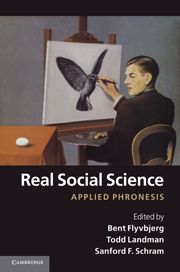Book contents
- Frontmatter
- Contents
- Figures
- Tables
- Contributors
- Acknowledgements
- 1 Introduction: new directions in social science
- Part I Theory and method
- 2 Phronetic social science: an idea whose time has come
- 3 Phronesis and narrative analysis
- 4 The feel for power games: everyday phronesis and social theory
- 5 Phronesis, projects and power research
- Part II Applied phronesis
- 6 Why mass media matter and how to work with them: phronesis and megaprojects
- 7 Power and conflict in collaborative research
- 8 Unsettling a settler society: film, phronesis and collaborative planning in small-town Canada
- 9 Phronesis and critical policy analysis: Heathrow's ‘third runway’ and the politics of sustainable aviation in the United Kingdom
- 10 Amnesty in the age of accountability: Brazil in comparative context
- 11 Feminist phronesis and technologies of citizenship
- 12 Making the teaching of social justice matter
- 13 Spatial phronesis: a case study in geosurveillance
- 14 Important next steps in phronetic social science
- Index
- References
8 - Unsettling a settler society: film, phronesis and collaborative planning in small-town Canada
Published online by Cambridge University Press: 05 June 2012
- Frontmatter
- Contents
- Figures
- Tables
- Contributors
- Acknowledgements
- 1 Introduction: new directions in social science
- Part I Theory and method
- 2 Phronetic social science: an idea whose time has come
- 3 Phronesis and narrative analysis
- 4 The feel for power games: everyday phronesis and social theory
- 5 Phronesis, projects and power research
- Part II Applied phronesis
- 6 Why mass media matter and how to work with them: phronesis and megaprojects
- 7 Power and conflict in collaborative research
- 8 Unsettling a settler society: film, phronesis and collaborative planning in small-town Canada
- 9 Phronesis and critical policy analysis: Heathrow's ‘third runway’ and the politics of sustainable aviation in the United Kingdom
- 10 Amnesty in the age of accountability: Brazil in comparative context
- 11 Feminist phronesis and technologies of citizenship
- 12 Making the teaching of social justice matter
- 13 Spatial phronesis: a case study in geosurveillance
- 14 Important next steps in phronetic social science
- Index
- References
Summary
Prologue
Five years ago we heard three anecdotes about the small town of Burns Lake in northern British Columbia that whetted our phronetic research appetite, as well as our evolving interest in film as a mode of inquiry and a way of approaching collaborative and transformational planning. This northern interior town has a population of 3,000 people, almost equally divided between First Nations (indigenous) and non-Native Canadians, the latter constituting the ‘settler society’. The first anecdote reported a kind of ‘High Noon’ conflict between the municipality of Burns Lake and one of the First Nations bands, the Burns Lake Band (whose preferred name is Ts'il Kaz Koh First Nation). As part of a dispute over land and taxation which culminated in the year 2000, the municipality shut off water and sewer services to the Burns Lake Band's Reserve, in the middle of winter (in a region where winter temperatures in February are typically –30°C). To our then innocent ears that seemed like a pretty shocking situation. How could there be such an apparent affront to basic human rights, we wondered, in twenty-first-century Canada, a country with a rather stellar record of defending human rights abroad? How could such injustice and seemingly blatant racism be happening and how could the perpetrator be an arm of the state, namely, local government?
The second anecdote told how in 2005 some of the local youth in the town had gotten together, Native and non-Native, and written and performed a song about racism and violence in the town, calling their song ‘Leave it Behind’. This raised a second question of whether and how, amid a history of segregation and conflict, some people were struggling to change things, and how well were they faring? And, third, we learned that in the municipal elections of 2005 a member of the Burns Lake Band had been elected to the Village Council, the only Native person ever to serve on that Council. What effect would this have on local politics? Was the local power structure changing or were there more subtle shifts in power occurring, and, if so, how and why? And what potential effect might our research have in aiding this shift towards more equitable economic, social and political relations between Native and non-Native Canadians in this town, and possibly beyond, through the power of their story? These were the questions that prompted us to make an exploratory trip to the town in the summer of 2006.
- Type
- Chapter
- Information
- Real Social ScienceApplied Phronesis, pp. 137 - 166Publisher: Cambridge University PressPrint publication year: 2012
References
- 14
- Cited by



